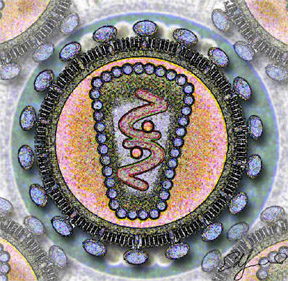Human Immunodeficiency Virus (HIV): Difference between revisions
Jump to navigation
Jump to search
| Line 48: | Line 48: | ||
==The clinical course of infection== | ==The clinical course of infection== | ||
:''For more details on this topic, see [[AIDS#Diagnosis|AIDS Diagnosis]], [[AIDS#Symptoms and Complications|AIDS Symptoms and Complications]] and [[WHO Disease Staging System for HIV Infection and Disease]]'' | :''For more details on this topic, see [[AIDS#Diagnosis|AIDS Diagnosis]], [[AIDS#Symptoms and Complications|AIDS Symptoms and Complications]] and [[WHO Disease Staging System for HIV Infection and Disease]]'' | ||
==HIV test== | ==HIV test== | ||
Revision as of 21:16, 23 April 2012
Template:DiseaseDisorder infobox
| Human immunodeficiency virus | ||||||
|---|---|---|---|---|---|---|
 Stylized rendering of a cross section
of the human immunodeficiency virus | ||||||
| Virus classification | ||||||
| ||||||
| Species | ||||||
|
To read more about AIDS, click here.
To read about the difference between HIV & AIDS, click here.
Editor-In-Chief: C. Michael Gibson, M.S., M.D. [1] Template:HIV
Overview
Origin and discovery
- See AIDS origin
Classification
Early history
- See History of known cases and spread for early cases of HIV / AIDS
Transmission
Structure and genome
Tropism
Replication cycle
Genetic variability
The clinical course of infection
- For more details on this topic, see AIDS Diagnosis, AIDS Symptoms and Complications and WHO Disease Staging System for HIV Infection and Disease
HIV test
Treatment
Epidemiology
AIDS denialism
A small minority of scientists and activists question the connection between HIV and AIDS,[1] the existence of HIV itself,[2] or the validity of current testing and treatment methods. These claims have been examined and widely rejected by the scientific community,[3] although they have had a political impact, particularly in South Africa, where governmental acceptance of AIDS denialism has been blamed for an ineffective response to that country's AIDS epidemic.[4][5][6]
Related Chapters
- AIDS
- HIV disease
- Hepatitis C with HIV coinfection
- Hepatitis B with HIV coinfection
- Tuberculosis and HIV coinfection
- HIV and tuberculosis coinfection : drug interaction
References
- ↑ Duesberg, P. H. (1988). "HIV is not the cause of AIDS". Science. 241 (4865): 514, 517. doi:10.1126/science.3399880. PMID 3399880.
- ↑ Papadopulos-Eleopulos, E., Turner, V. F., Papadimitriou, J., Page, B., Causer, D., Alfonso, H., Mhlongo, S., Miller, T., Maniotis, A. and Fiala, C. (2004). "A critique of the Montagnier evidence for the HIV/AIDS hypothesis". Med Hypotheses. 63 (4): 597&ndash, 601. PMID 15325002.
- ↑ For evidence of the scientific consensus that HIV is the cause of AIDS, see (for example):
- "The Durban Declaration". Nature. 406 (6791): 15–6. 2000. doi:10.1038/35017662. PMID 10894520. - full text here.
- Cohen, J. (1994). "The Controversy over HIV and AIDS" (PDF). Science. 266 (5191): 1642&ndash, 1649.
- Various. "Focus on the HIV-AIDS Connection: Resource links". National Institute of Allergy and Infectious Diseases. Retrieved 2006-09-07.
- O'Brien SJ, Goedert JJ (1996). "HIV causes AIDS: Koch's postulates fulfilled". Curr. Opin. Immunol. 8 (5): 613–8. PMID 8902385.
- Galéa P, Chermann JC (1998). "HIV as the cause of AIDS and associated diseases". Genetica. 104 (2): 133–42. PMID 10220906.
- ↑ Watson J (2006). "Scientists, activists sue South Africa's AIDS 'denialists'". Nat. Med. 12 (1): 6. doi:10.1038/nm0106-6a. PMID 16397537.
- ↑ Baleta A (2003). "S Africa's AIDS activists accuse government of murder". Lancet. 361 (9363): 1105. doi:10.1016/S0140-6736(03)12909-1. PMID 12672319.
- ↑ Cohen J (2000). "South Africa's new enemy". Science. 288 (5474): 2168–70. doi:10.1126/science.288.5474.2168. PMID 10896606.
External links
- UNAIDS - Joint United Nations Programme on HIV/AIDS webpage
- PlusNews, The United Nations HIV and AIDS news service
- History of AIDS research at the NIH
- Medecins Sans Frontieres/Doctors Without Borders HIV/AIDS Pages
- AIDSinfo - HIV/AIDS Information - Comprehensive resource for HIV/AIDS treatment and clinical trial information from the U. S. Department of Health and Human Services
- HIV InSite - University of California San Francisco
- AIDS.ORG: Educating - Raising HIV Awareness - Building Community
- AIDSPortal - Latest policy, research, guidelines and case studies
- AIDS.gov Portal for all Federal domestic HIV/AIDS information and resources
- News media
- "The Age of Aids" March 30, 2006 Frontline
- Everything you wanted to know about HIV and AIDS — Provided by New Scientist.
- "The Graying of AIDS" - Older Americans living with HIV face unique challenges - TIME magazine, 08/14/06
- "Elite" HIV patients mystify doctors - Aug 16, 2006 | Reuters on Topix.net
- Online textbooks
- HIV Medicine 2006, medical textbook, 14th edition, 825 pages (free download)
- "The Molecules of HIV" information resource
- Advocacy
- Be the Generation - Information on HIV Vaccine Clinical Research in 20 American Cities
- Media Campaign: HIV leads to AIDS
- FightAIDS@Home
- HIV-AIDS-Counseling-Online.com
- Articles
- The Mechanism of HIV-1 Core Assembly: Insights from Three-Dimensional Reconstructions of Authentic Virions
- Unsafe Health Care and the HIV/AIDS Pandemic 2003
- The role of dendritic cells in HIV pathogenesis
- The HIV databases, Los Alamos National Laboratory
- Multimedia/video
- HIV DERMATOLOGY
- How Aids Works (with animation)
- Watch an animated tutorial on the life cycle of HIV
- Video of Treatment Update 2006 from the Conference on Retrovirus'
- Other sites
- HIV/AIDS at About.com provides a comprehensive collection of HIV and AIDS information, articles, statistics, and forums.
- POZ provides information and networking opportunities for the HIV community.
- AIDSmeds is a place to find complete and easy-to-read information on treating HIV & AIDS.
- AEGiS.org: AIDS Education Global Information System- Patient/clinician information & Historical news and treatment database
- AIDS Community Research Initiative of America - Community-based research and education for people living with HIV
- Data about people living with HIV/AIDS in the world (regional totals and percentage of adults with AIDS that are women)- from Data360
- Resources for HIV/AIDS and Sexual and Reproductive Health Integration Johns Hopkins Bloomberg School of Public Health, Center for Communication Programs